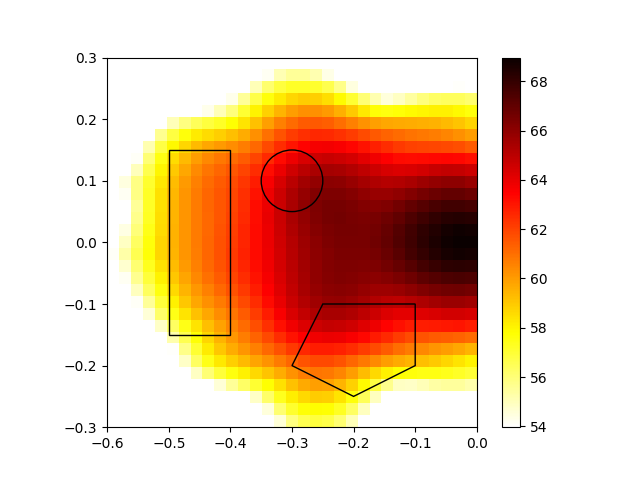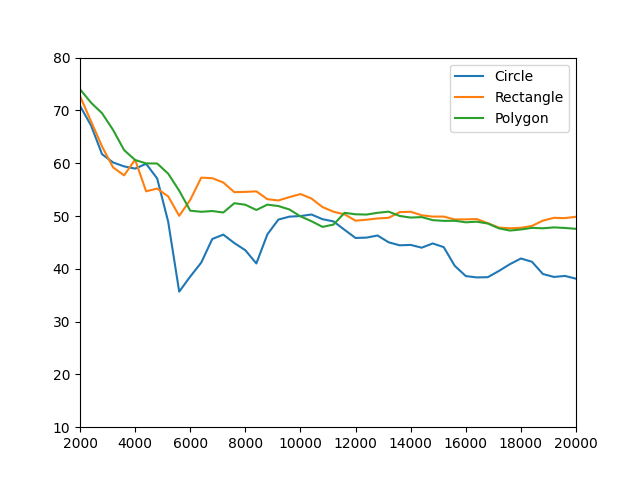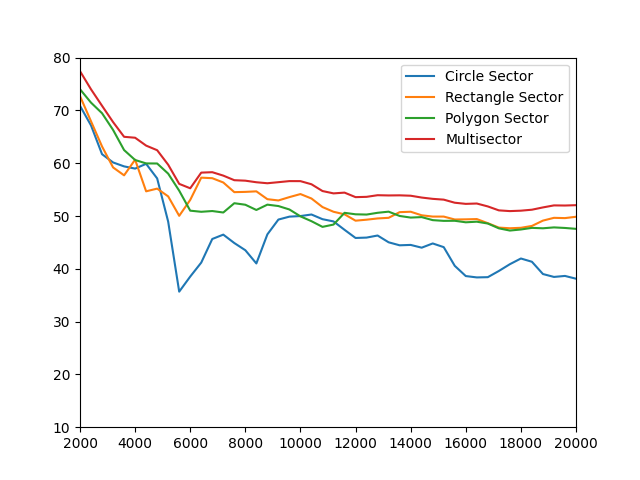Note
Go to the end to download the full example code.
Sector Integration Example#
Loads the example data set, sets diffrent Sectors for intergration. Shows Acoular’s Sector und Sound Pressure level Integration functionality.
Obtain necessary data
time_data_file = get_data_file('example_data.h5')
Define the necessary objects
micgeofile = Path(ac.__file__).parent / 'xml' / 'array_56.xml'
mg = ac.MicGeom(file=micgeofile)
ts = ac.TimeSamples(file=time_data_file)
ps = ac.PowerSpectra(source=ts, block_size=128, window='Hanning')
rg = ac.RectGrid(x_min=-0.6, x_max=-0.0, y_min=-0.3, y_max=0.3, z=-0.68, increment=0.02)
st = ac.SteeringVector(grid=rg, mics=mg)
f = ac.PowerSpectra(source=ts, block_size=128)
bf = ac.BeamformerBase(freq_data=f, steer=st)
Integrate function can deal with multiple methods for integration:
a circle containing of three values: x-center, y-center and radius
a rectangle containing of 4 values: lower corner(x1, y1) and upper corner(x2, y2).
a polygon containing of vector tuples: x1,y1,x2,y2,…,xi,yi
4th alternative: define those sectors as Classes
circle_sector = ac.CircSector(x=-0.3, y=-0.1, r=0.05)
rect_sector = ac.RectSector(x_min=-0.5, x_max=-0.4, y_min=-0.15, y_max=0.15)
PolySector is a class that takes a list of points as input
list of points containing x1,y1,x2,y2,…,xi,yi
poly_sector = ac.PolySector(edges=[-0.25, -0.1, -0.1, -0.1, -0.1, -0.2, -0.2, -0.25, -0.3, -0.2])
The MultiSector class allows to sum over multiple different sectors
multi_sector = ac.MultiSector(sectors=[circle_sector, rect_sector, poly_sector])
Two integration variants exist (with same outcome): 1. use Acoular’s integrate function. Integrate SPL values from beamforming results using the shapes
levels_circ = ac.integrate(bf.result[:], rg, circle)
levels_rect = ac.integrate(bf.result[:], rg, rect)
levels_poly = ac.integrate(bf.result[:], rg, poly)
[('example_data_cache.h5', 18)]
[('example_data_cache.h5', 19)]
integrate SPL values from beamforming results using sector classes
levels_circ_sector = ac.integrate(bf.result[:], rg, circle_sector)
levels_rect_sector = ac.integrate(bf.result[:], rg, rect_sector)
levels_poly_sector = ac.integrate(bf.result[:], rg, poly_sector)
levels_multi_sector = ac.integrate(bf.result[:], rg, multi_sector)
2. use beamformers integrate function (does not require explicit assignment of grid object). Integrate SPL values from beamforming results using the shapes
levels_circ = bf.integrate(circle)
levels_rect = bf.integrate(rect)
levels_poly = bf.integrate(poly)
integrate SPL values from beamforming results using sector classes
levels_circ_sector = bf.integrate(circle_sector)
levels_rect_sector = bf.integrate(rect_sector)
levels_poly_sector = bf.integrate(poly_sector)
levels_multi_sector = bf.integrate(multi_sector)
Plot map and sectors
plt.figure()
map = bf.synthetic(2000, 1)
mx = ac.L_p(map.max())
plt.imshow(ac.L_p(map.T), origin='lower', vmin=mx - 15, interpolation='nearest', extent=rg.extent, cmap=plt.cm.hot_r)
plt.colorbar()
circle1 = plt.Circle((-0.3, 0.1), 0.05, color='k', fill=False)
plt.gcf().gca().add_artist(circle1)
polygon = Polygon(poly.reshape(-1, 2), color='k', fill=False)
plt.gcf().gca().add_artist(polygon)
rect = Rectangle((-0.5, -0.15), 0.1, 0.3, linewidth=1, edgecolor='k', facecolor='none')
plt.gcf().gca().add_artist(rect)
# calculate the discrete frequencies for the integration
fftfreqs = np.arange(128 / 2 + 1) * (51200 / 128)
# plot from shapes
plt.figure()
plt.plot(fftfreqs, ac.L_p(levels_circ))
plt.plot(fftfreqs, ac.L_p(levels_rect))
plt.plot(fftfreqs, ac.L_p(levels_poly))
plt.xlim([2000, 20000])
plt.ylim([10, 80])
plt.legend(['Circle', 'Rectangle', 'Polygon'])
# plot from sector classes
plt.figure()
plt.plot(fftfreqs, ac.L_p(levels_circ_sector))
plt.plot(fftfreqs, ac.L_p(levels_rect_sector))
plt.plot(fftfreqs, ac.L_p(levels_poly_sector))
plt.plot(fftfreqs, ac.L_p(levels_multi_sector))
plt.xlim([2000, 20000])
plt.ylim([10, 80])
plt.legend(['Circle Sector', 'Rectangle Sector', 'Polygon Sector', 'Multisector'])
plt.show()
Total running time of the script: (0 minutes 0.769 seconds)



